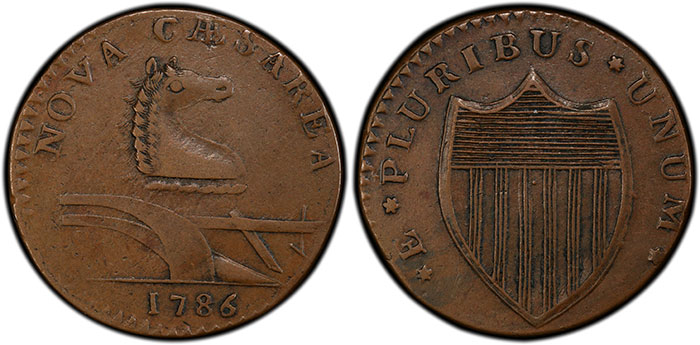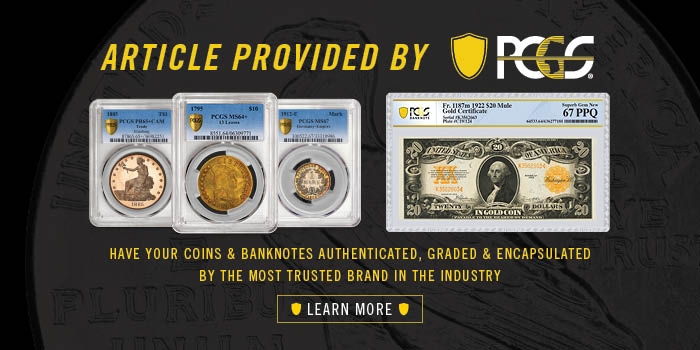By Gordon Wrubel for for PCGS ……
In 1881 Dr. Edward Maris published his comprehensive study of the New Jersey copper die varieties. These were described and classified with a number for the obverse and letter for the reverse die. Example: 6-D, 18-M, 63-r.
Nearly all the famous collectors of the 19th century such as Mickley, Dickeson, Bushnell, Crosby, Stickney, Dr. Maris himself, and others were keenly interested in colonials, especially New Jersey coppers.
The state of New Jersey had a dire need for a circulating small denomination copper coin to facilitate business.
Three coiners–Albion Cox, Thomas Goadsby, and Walter Mould–had emigrated from England, circa 1783. Mould was the only accomplished “die sinker” of the group. They produced patterns and sought to secure a federal coinage contract, which was not granted to them. The group then successfully lobbied for a contract to strike New Jersey coppers.
The New Jersey Assembly passed the contract for the production of three million coppers on June 1, 1786. However, legal disputes between the three coiners resulted in a revised copper coinage bill that was finally approved on November 22, 1786. This event gave Mould the right to coin one million of the coppers on his own. With the help of financial backers, Mould set up his coining operation in Morristown, New Jersey.
The state Supreme Court mandated the design for the coinage. The obverse features the head of a horse, with a plow below, as found on the New Jersey state seal. The Latin inscription above “Nova Caesarea” translates to “New Jersey”. The reverse features a shield with the inscription “E PLURIBUS UNUM” above, translating to “Out of Many One”.

1786 New Jersey copper PCGS AU50
Walter Mould’s Morristown mint was operational by late January 1787. It has been speculated that his first die, now designated Maris 62 1/2-r, was rejected by the state treasurer for non-compliance with the specifications of the design. Mould, in accordance with the English tradition of engravers signing their work, put his initials “WM” under the truncation of the horse. But this speculation did not come to light for more than 200 years! In 1994, a lone example of the “WM” initialed die was discovered. To this day, the “WM” specimen is unique.
In 1994, colonial coin expert Michael Hodder declared this specimen as “The most spectacular and important discovery in the field of early American and state copper numismatics.” The “WM” piece was authenticated and graded VF25 by PCGS in 1994 and placed in an oversized green Regency holder.
The asking price by the owners at that time was $1 million. There were no takers, so the price was lowered a few times coming down to $500,000 and less, with still no takers. Ultimately, the owners decided to consign the piece to a Bowers and Merena Rarities auction in August 1996. The lot brought a reasonable $143,000 USD.
But the story is not yet complete. Because of the (speculated) rejection of Mould’s first dies, he produced a new 62 obverse die, designated 62-r, and refined the reverse design for Maris 62-q. This latter die was a beautiful and artistic example of a master die sinker’s hand. Maris 62-q he coined in earnest, making it one of the most common New Jersey die varieties.
But instead of removing his initials from under the horse’s head, he merely obscured them with a three-leaf sprig! This fact would be reported in a 2004 article by colonial coin collector/expert Roger Siboni, titled “The Not-So-Hidden Hand of Walter Mould”. A close-up photo of the sprig clearly showed the left arm of the “W” as well as the top and right stand of the “M” under the sprig.

Close up of sprig on obverse. Look towards the top left leaf to see a partial “W” and look towards the right leaf to see a partial “M”.
Since the exposed “WM” coin is unique and now in a spectacular East Coast collection, the 62-q has been dubbed the “Poor Man’s WM copper”.
It is this writer’s opinion that Walter was not done yet!
Maris obverse die #6 (6-C, 6-D) has been attributed to Mould’s Morristown mint. A distinctive feature of this die is the ears of the horse. They are sharply pointed and linear like two conjoined triangles placed atop the horse’s head, forming a perfect M. No other set of ears in the entire series has this configuration. Even Dr. Maris, in his 1881 masterwork, described this die as “ears like an M.” One must suspect that Mould, again, found a clever and covert way to sign his work.

Close up of well-defined horse ears (1787 NJersy PCGS AU55)
NOTE: In 2013, the magnum opus New Jersey Coppers was published jointly by the American Numismatic Society (ANS) and the Colonial Coin Collectors Club (C4). The authors, Roger S. Siboni, John L. Howes, and A. Buell Ish, are renowned experts in the field of colonial coins, and especially New Jersey coppers. Their exhaustive research covers all areas of the subject: the history of the era, the coiners, and collectors past and present. There are large color photos with detailed descriptions of every know die pairing. Included are rarity ratings, a named condition census, with ownership history, as well as survival estimates and more! This 500 plus page tome, a must-read, has everything one may want to know about the subject.
* * *





